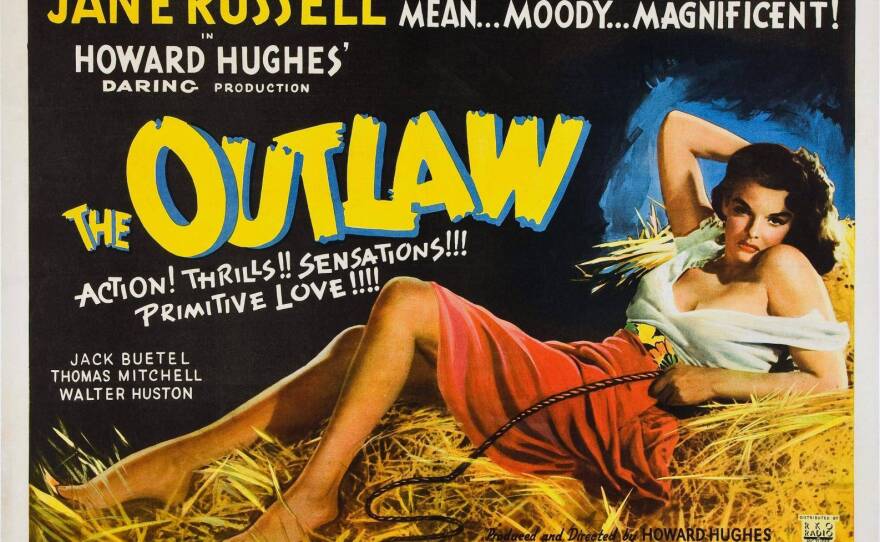HOST INTRO: What do Queen Christina, From Russia With Love, and Ice Castles all have in common? They all so offended the Catholic Church that they received the dreaded C rating for condemned. KPBS film critic Beth Accomando says tonight Turner Classic Movies begins a 27-film program called Condemned that looks at the influential and powerful impact Catholic Legion of Decency had on the film industry for more than four decades. In 1933 an effervescent Ernst Lubitsch comedy called Design for Living gave us two men and a woman living cozily together with a gentleman’s agreement of no sex. But then the woman played by Miriam Hopkins points out the sexual inequity that makes it socially acceptable for men to experiment before marriage. DESIGN FOR LIVING [Men can meet 2-3 women and fall in love with all of them and then by a process of interesting elimination he would be able to decide which one he prefers] but a woman must decide purely on instinct, guess work to be considered nice, she can try on 100 hats… which chapeau does madam want… both. (:28) SISTER ROSE PACATTE: Yeah that would have irritated them…It was all about temptation or attraction and marriage and maybe treating marriage in a frivolous way and so the pervasiveness of the theme irritated them and called down the condemnation of the Legion of Decency. That’s Sister Rose Pacatte. Turner Classic Movies has selected a nun who also happens to be a respected film critic as the person to guide us through 47-years of salacious filmmaking for its new monthly spotlight called Condemned. TCM will look to the history of the Legion, and it’s impact on how films were made to avoid receiving the dreaded “C” label, a designation that could keep a film out of theaters and force a studio to cut out any offending parts. Charles Tabesh is senior vice president for programming at TCM. CHARLES TABESH: The members of the Church listened to what they had to say I remember my grandmother back in the 1970s wouldn’t go to movies that were on this list that the Church had deemed inappropriate. Will McKinley is a blogger and active member of the TCM social media community. He attended Catholic school for 12 years. WILL McKINLEY: It does remind me of childhood where letters would come home from Catholic school to my parents telling them to tell us to not watch things… Anything that doesn’t follow the commandments or the catechism of the Catholic Church, I mean it’s so odd because during the period of time the Legion Of Decency held sway certainly the majority of the country was not Catholic but to a large degree their entertainment was being dictated by Catholic precepts. Premarital sex was out so too was homosexuality, abortion, divorce, and anything that cast the Church in a negative light, like 1947’s Black Narcissus. Sister Rose reads from the Legion of Decency’s assessment of the film. SISTER ROSE: “an affront to religion that ignores the spiritual motivation, which is the foundation and safeguard of religious life, and offensively tries to characterize such life as an escape for the abnormal, neurotic, and frustrated…” Four years earlier The Outlaw stirred moral outrage with the buxom Jane Russell whose blouse kept slipping alluringly off her shoulders. THE OUTLAW most exciting entertainment ever seen… savage love, primitive emotions… WILL McKINLEY: You just get a vision of red faced priests in 1943 taking their pulse to make sure they didn’t have a heart attack. But McKinley notes that things started to change in the 1950s with The Moon is Blue… MOON IS BLUE TRAILER And now with the same engaging characters, the same hilarious situations, the same provocative lines, The Moon is Blue has at last hit the screen. Those provocative lines included words like seduce and professional virgin. But what proved most shocking was that the film bypassed both the Legion of Decency and the industry’s own production code to be released in theaters. That’s when people began to see the Legion’s condemnation as something to be mocked rather than adhered to. But TCM kicks off its Condemned series with a banner year for the Legion – 1933, a year so filled with vile, unwholesome, and depraved films that it gave birth to the Legion, which immediately got busy condemning 22 motion pictures. For KPBS News, I’m Beth Accomando.
What do “Queen Christina,” “From Russia With Love,” and “The Odd Couple” all have in common? They all so offended the Catholic Church that they received the dreaded “C” rating for condemned.
Thursday night Turner Classic Movies begins a 27-film program called "Condemned" that looks at the influential and powerful impact the Catholic Legion of Decency had on the film industry for more than four decades.
In 1933, an effervescent Ernst Lubitsch comedy called “Design for Living” gave us two men and a woman living cozily together under a gentlemen’s agreement of no sex. But then the woman, played by Miriam Hopkins, points out the sexual inequity that makes it socially acceptable for men to experiment before marriage but not women.
Gilda: "Men can meet 2-3 women and fall in love with all of them and then by a process of interesting elimination he would be able to decide which one he prefers but a woman must decide purely on instinct, guess work to be considered nice, oh it’s quite all right for her to try on 100 hats before she picks out one…"
Tom: "Which chapeau does madam want?"
Gilda: "Both.“
Turner Classic Movies has selected Pacatte, a nun who also happens to be a respected film critic for two Catholic media outlets, as the person to guide us through 47 years of salacious filmmaking for its new monthly spotlight called "Condemned."
TCM will look to the history of the Legion of Decency, and it’s impact on how films were made to avoid receiving the “C” label, a designation that could keep a film out of theaters and force a studio to cut out any offending parts.
“The members of the Church listened to what they had to say,” Charles Tabesh said. He is senior vice president for programming at TCM. “I remember my grandmother back in the 1970s wouldn’t go to movies that were on this list that the Church had deemed inappropriate.”
In one of the introductions, Sister Rose recalls the pledge Catholics had to take every year. It read: “I condemn absolutely those salacious motion pictures which, with other degrading agencies, are corrupting public morals and promoting a sex mania in our land.”
Will McKinley is a blogger and active member of the TCM social media community. He also attended Catholic school for 12 years.
“It does remind me of childhood where letters would come home from Catholic school to my parents telling them to tell us to not watch things — anything that doesn’t follow the commandments or the catechism of the Catholic Church," he said. "I mean it’s so odd because during the period of time the Legion Of Decency held sway certainly the majority of the country was not Catholic but to a large degree their entertainment was being dictated by Catholic precepts.”

Premarital sex was out, so too was homosexuality, abortion and divorce. The Legion also didn’t look favorably on questioning authority or on Jane Russell’s full figure in a blouse that kept slipping alluringly off her shoulders. Both of which were found in Howard Hughes’ 1943 film, “The Outlaw.”
“You just get a vision of red-faced priests in 1943 taking their pulse to make sure they didn’t have a heart attack,” McKinley said of the Legion’s decision to condemn “The Outlaw.”
“TCM’s 'Condemned' allows you to follow the course of film censorship in this nation over a 47-year period,” McKinley added. “You can watch as the goal posts slip further and further back so something that would be completely forbidden in 1933 was kind of OK maybe after the war.”
But some things never sat well with the Legion like casting the Church in a negative light, as they claimed 1947’s "Black Narcissus" did.

In her introduction to the film, Sister Rose said:
“The Legion of Decency had a fit and condemned it in the pages of Variety as ‘an affront to religion that ignores the spiritual motivation, which is the foundation and safeguard of religious life, and offensively tries to characterize such life as an escape for the abnormal, neurotic, and frustrated…’ A Catholic paper in LA called it a ‘perverted specimen of bad taste and ludicrous improbabilities.’ That must have been written by a man who has no idea what goes on in the lives of nuns, human beings like everyone else.”
Sister Rose brings a balanced perspective to the series. She criticizes the Church for not considering context along with content. But she also defends it for what she calls “doing its job” of supporting Catholic beliefs by condemning “The Carey Treatment” for presenting pro-choice ideas about abortion.
In the 1950s the Legion of Decency faced challenges to its authority. The Church’s condemnation of Roberto Rosselini’s “L’Amore” led to a Supreme Court decision in 1952 that declared film a form of artistic expression protected by First Amendment rights. Then Otto Preminger’s 1953 film “The Moon is Blue” included such provocative words as “seduce” and “professional virgin” but bypassed both the Legion of Decency and the industry’s own Hays Code to get released in theaters. That’s when people began to see the Legion’s condemnation as something to be ignored and even mocked.
The Church tried to exert its influence into the 1970s and even early '80s but without the impact it had in earlier decades. Sister Pacatte says the Church still maintains a rating system today through the Catholic News Service in Washington, D.C. which uses an “O” rating for Morally Offensive rather than the more severe sounding “C” for Condemned (the change in rating took place in 1978).
TCM kicks off its "Condemned" series with a quartet of films from 1933, a year so filled with vile, unwholesome, and depraved films that it gave birth to the Legion of Decency, which immediately got busy condemning 22 motion pictures.
You can listen to my full interviews with movie clips on the Cinema Junkie Podcast.
And I urge you to participate in the live Tweeting events for each night of Condemned films with TCM Party.

Thursday, March 3
8 p.m.: “The Story of Temple Drake” (1933, not available of DVD or Blu-ray)
10 p.m.: “Black Narcissus” (1947)
11:30 p.m.: “Design For Living” (1933)
1:15 a.m.: "The Outlaw” (1943)
3:30 a.m.: “Baby Face” (1933)
5 a.m.: “Wild Boys of the Road” (1933)

Thursday, March 10
8 p.m.: “M” (1951, not available of DVD or Bluray)
9:45 p.m.: “The French Line” (1954, not available on DVD or Blu-ray)
11:45 p.m.: “And God Created Woman” (1956)
1:30 a.m.: “Untamed Youth” (1957)
3:00 a.m.: “Breathless” (1960)

Thursday, March 17
8 p.m.: “Viridiana” (1961)
9:45 p.m.: “Kiss Me, Stupid” (1964)
12 a.m.: “Blow-Up” (1966)
2 a.m.: “Never on Sunday” (1960)
3:45 a.m.: “Reflections in a Golden Eye” (1967)

Thursday, March 24
8 p.m.: “The Carey Treatment” (1972)
10 p.m.: “The Competition” (1980)
12:15 a.m.: “Those Lips, Those Eyes” (1980)
2:15 a.m.: “Lemora, A Child’s Tale of the Supernatural” (1973)
4 a.m.: “Ice Castles” (1978)

Thursday, March 31: TCM Spotlight: Condemned – Special Circumstances
8 p.m.: “The Moon Is Blue” (1953) (Condemned by the Legion and bypassed the Production Code entirely)
10 p.m.: “Baby Doll” (1956) (Condemned by the Legion but approved by the Production Code)
12:15 a.m.: “L’Amore” (1948) (Condemned by the Legion, led to Supreme Court lawsuit in 1952 known as the "Miracle Decision" which declared the film was a form of artistic expression protected by the freedom of speech guarantee of the First Amendment to the United States Constitution; not available of DVD or Blu-ray)
1:45 a.m.: “Strange Cargo” (1940) (Condemned by the Legion, studio released a cut version)
3:45 a.m.: “Rififi” (1954) (Condemned by the Legion, changed to a B rating after being re-released)
5:45 a.m.: “Love in the Afternoon” (1957) (Condemned by the Legion, studio changed ending)

Some notable landmarks:
“Baby Face” (1933) – Barbara Stanwyck uses sexuality to get ahead.
“And God Created Woman” (1956) – The French film created Brigitte Bardot’s “sex kitten” image.
“Kiss Me, Stupid” (1964) – Billy Wilder’s comedy about a singer who has to have sex regularly to avoid headaches.
“The Carey Treatment” (1972) – Blake Edwards thriller revolving around illegal abortion.
“The Moon Is Blue” (1953) - The film was condemned by the Legion and bypassed the Production Code entirely.
“L’Amore” (1948) - Led to a Supreme Court lawsuit in 1952 known as the “Miracle Decision” after being condemned by the Legion. The ruling declared that motion pictures were a form of artistic expression protected by the freedom of speech and guaranteed under the First Amendment.







